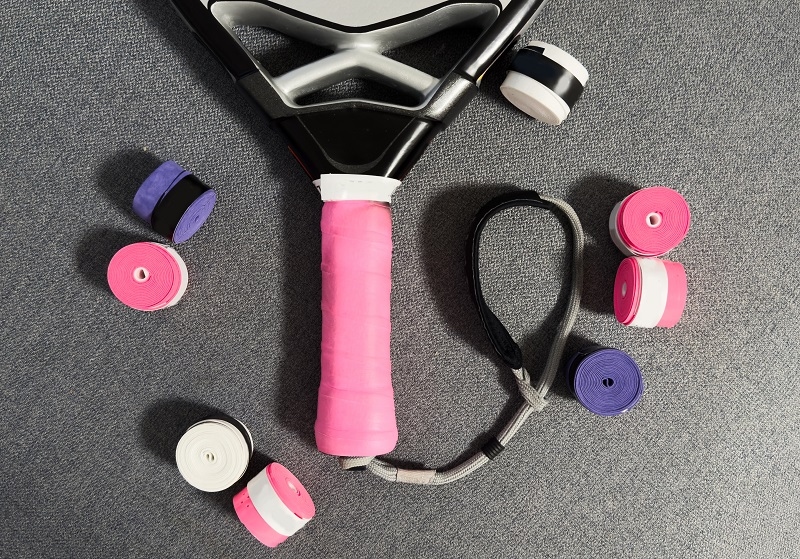
Close
If you think tennis is just about powerful swings and quick footwork, think again. Every shot starts with one fundamental: your grip. And not just any grip, but the right grip. Whether you’re whipping forehands cross-court or slicing a low backhand, your choice of grip can make or break the shot.
Let’s break down the different tennis grips, what each one does, and when to use them. Whether you're new to the game or tweaking your form, this no-fluff guide has you covered.
Grip controls everything — your spin, your power, your shot depth. A great swing means nothing if your grip’s off. So if you're wondering why your topspin forehand keeps landing in the net or your volleys float long, don’t just blame timing — check your tennis racket grip.
Different tennis grip types affect the angle of the racket face, your wrist mobility, and how easily you can switch between strokes. Nail the grip, and you’ll start hitting like you actually meant to.
Your grip is also where injury prevention starts. Using the wrong forehand grip for tennis not only affects control but can overload your wrist and forearm. That’s how tennis elbow creeps in. Playing smarter starts with holding smarter.
More to Discover: Serving Success: Tennis Tips for Players of All Skill Levels
Also known as the “hammer grip,” this one’s the Swiss Army knife of grips. Place your base knuckle on bevel #2. It’s the go-to tennis continental grip and it covers:
You won’t use it for forehands unless you’re stuck in 1950. But for everything else? Essential.
Pros: Fast transitions, great for touch shots and volleys.
Cons: Terrible for topspin. Don’t use this as your forehand grip for tennis unless you want to frame every shot.
The tennis continental grip is also ideal when you're improvising — think half-volleys, drop shots, or quick flicks at the net. It's the grip that saves you when you've got no time to think.
This one’s your handshake with the racquet — literally. Rest your index knuckle on bevel #3. The eastern grip tennis players use is perfect for hitting flat and clean.
Best for:
Pros: Great blend of control and power. Works well on low balls.
Cons: Doesn’t generate a ton of topspin. Modern baseliners might find it limiting.
Still, if you’re just learning how to find your tennis racket grip, Eastern is a strong starting point.
This grip also makes it easier to redirect pace — ideal if you’re up against big hitters and want to absorb their power without overthinking your swing mechanics.
Welcome to the modern game. The semi-western is the most popular forehand grip for tennis right now — and for good reason. Place your knuckle on bevel #4 and you’ll feel why.
Why it works:
Drawbacks? Low balls are harder to dig out, and it's not the fastest grip to transition to volleys.
Still, if you're serious about learning all the key types of tennis grips, this one's non-negotiable.
What makes it so dominant? Spin plus depth. Players using the semi-western can push opponents deep behind the baseline and still keep the ball in. It’s the perfect balance of offense and margin.

This is what happens when players crank their grip even further around — knuckle on bevel #5. If you’ve watched clay-court grinders hit balls that bounce over your head, this is the grip doing the damage.
Pros: Max topspin. Massive ball clearance.
Cons: Useless for low balls. Volleys feel like punishment. And unless you’ve got solid timing, mishits are common.
Not for the faint-hearted, but definitely one of the more extreme tennis grip types out there.
It thrives on clay or slow courts. With a Western grip, you can create crazy angles and dip shots into the corners. But miss your timing or play on grass? You’ll suffer.
You want to go full savage on spin? Here’s your ticket. The Hawaiian grip (bevel #6) is so aggressive it’s barely used on tour — but it exists.
Upside: Wild topspin and crazy angles.
Downside: Low balls are a nightmare. Volleys? Forget about it. Risk of wrist pain is high. Use with caution.
If you’re just starting out with tennis grips, skip this one for now.
This grip turns your racket face nearly vertical at contact. That’s why the spin is unmatched — and why consistency is hard to come by unless your timing is elite.
We’ve focused on forehands, but quick word on backhands:
Same rules apply — the grip influences spin, timing, and control.
Also, don’t overlook your non-dominant hand. It’s not just there for support. On a two-hander, it drives the swing. That’s why your backhand grip setup matters just as much.
Ask yourself:
If you’re a beginner, Eastern is your safest bet. Intermediate players should lean into the Semi-Western. If you're an advanced baseliner who lives for high-bouncing rallies, try Western.
And remember, your tennis grip types may shift as your game evolves.
Still unsure? Watch how pros grip their rackets. Federer used Eastern. Nadal’s closer to Western. Djokovic rides the line with Semi-Western. Find your comfort zone — and then build confidence from it.
Must Read: Preventing Tennis Injuries: Essential Tips for Safe Play
Here’s the deal — every grip comes with trade-offs. There’s no one-size-fits-all. Some grips are better for spin, others for flat drives. What matters is knowing when to use each and why.
A solid understanding of tennis grips is what separates average players from confident shot-makers. Whether you're learning the tennis continental grip for your serve or switching to eastern grip tennis for flatter baseline strokes, dialing in your grip is the smartest upgrade you can make.
Master your grip, and the rest of your game follows.